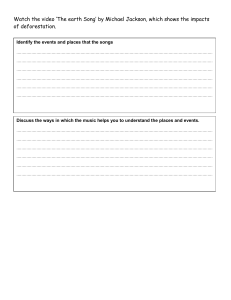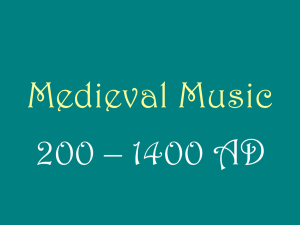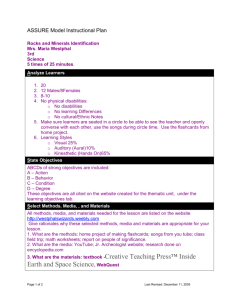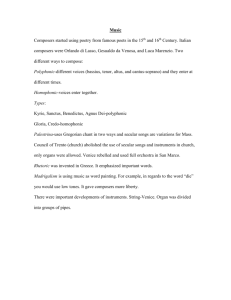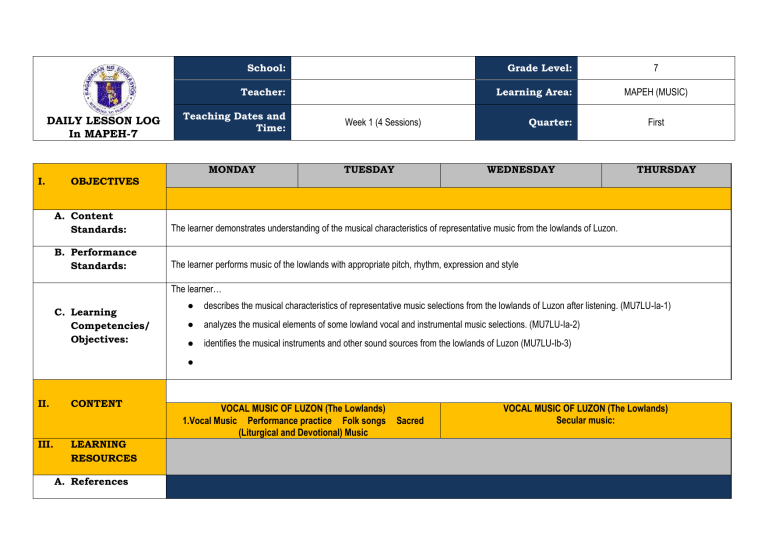
DAILY LESSON LOG In MAPEH-7 I. School: Grade Level: Teacher: Learning Area: Teaching Dates and Time: MONDAY OBJECTIVES Quarter: Week 1 (4 Sessions) TUESDAY WEDNESDAY A. Content Standards: The learner demonstrates understanding of the musical characteristics of representative music from the lowlands of Luzon. B. Performance Standards: The learner performs music of the lowlands with appropriate pitch, rhythm, expression and style 7 MAPEH (MUSIC) First THURSDAY The learner… C. Learning Competencies/ Objectives: ● describes the musical characteristics of representative music selections from the lowlands of Luzon after listening. (MU7LU-Ia-1) ● analyzes the musical elements of some lowland vocal and instrumental music selections. (MU7LU-Ia-2) ● identifies the musical instruments and other sound sources from the lowlands of Luzon (MU7LU-Ib-3) ● II. III. CONTENT LEARNING RESOURCES A. References VOCAL MUSIC OF LUZON (The Lowlands) 1.Vocal Music Performance practice Folk songs (Liturgical and Devotional) Music Sacred VOCAL MUSIC OF LUZON (The Lowlands) Secular music: 1. Teacher’s Guide Pages 2. Learner’s Materials Pages 3. Textbook Pages 4. Additional Materials from Learning Resource (LR) portal B. Other Learning Resources IV. PROCEDURES A. Reviewing previous lesson or presenting the new lesson (ELICIT) B. Establishing a purpose for the lesson (ENGAGE) Let the students recall the following musical symbols being flashed in the cards by naming them one by one. (whole note, quarter note, flat, g-clef, sharp, 2/4, half rest, bar line and dotted note). The teacher will ask the students these questions: Where do we used or see these symbols? What is the significance of these symbols to music? Play a guessing game about the different songs being played. (Manang Biday, Leron -Leron Sinta, and Magtanim ay di biro, Pasyon , Flores de Mayo, Santacruzan, and Salubong) . The students will render folksongs with the sacred music by group. They will be divided into four groups. Bahay Kubo Pasyon Leron Leron Sinta Flores De Mayo with the help of a laptop or projector. The students will pick the correct picture of a sacred music according to the description being given by the teacher on the board. (ex. Flores De Mayo, Santacruzan, Sitritsit, Bahay kubo, Senakulo and Paruparong Bukid) The students will recall the different Secular Music and Art music. The students will watch a video about the following Secular Music and Art music: Harana Balitaw Kumintang Polka Let the students form their own group. C. Presenting examples/ instances of the new lesson (EXPLORE) The teacher will lead the students to the realization that Philippines is rich in different kinds of music. 10 minutes Ask the students what are other songs that they have learned in their elementary years other than the songs that they have heard. The students will give their answers. Examples would be: Bahay Kubo, Ati Cu Pung Singsing, Sitsiritsit, Ang Pipit, and Salidumay. 5 minutes The teacher will discuss the meaning folk songs, Sacred and its examples by showing a PowerPoint about Philippine Folk and Sacred Music. D. Discussing new concepts and practicing new skills #1 (See attachment) The teacher will ask these questions regarding the PowerPoint: What is the meaning of a folk song/sacred music? What are the different types of folksongs and sacred music according to their functions? 1 Kundiman (see attachment) 10 minutes Let the students give their inner thoughts regarding the video they have watch. The learners will compare these to the variety of music we have today. 5 minutes The teacher will discuss the following Secular and Art music Harana Balitaw Kumintang Polka Kundiman 15 minutes Let the students give their own understanding about Secular Music. 5 minutes E. Discussing new concepts and practicing new skills #2 Ask the students among the Secular Music which is has a comparison to our music today? Let the students create their own interpretation of their chosen Secular Music or Art music. F. Developing mastery (leads to formative assessment) (EXPLAIN) The students will play the game “Name that tune.” The teacher will play the following songs like Bahay kubo, Sitsiritsit, Magtanim ay di Biro, Salubong, Pasyon and Flores De Mayo The students will choose a song from the Secular music and Art music and they will interpret it by means of singing by group. 10 minutes 10 minutes G. Finding practical application of concepts and skills in daily living Let the students choose a song from the given folksongs played. Then let them give their reactions or opinions about the songs. H. Making generalizations and abstractness to the lesson (ELABORATE) The students will give the distinguishing characteristics of Philippine Folk Music. 10 minutes V. REMARKS VI. REFLECTION Let the learners sum up the possible messages of the music. 5 minutes 5 minutes I. Evaluating learning (EVALUATION) J. Additional activities for application and remediation (EXTEND) The learners will connect a secular music to a certain story of life or experiences. Look for some additional examples of Folk Songs and Sacred Music List down some religious songs that you know The learners identifies the musical elements of the following folk songs and sacred music such as Leron,Leron Sinta, Pasyon, Magtanim ay Di Biro, Santacruzan, and Salubong Choose a song/music that you think it has something to do with your life. Write it down. The learners will compose a song by writing their own lyrics. (Kundiman version) Classify the following songs according to their characteristics: Nasaan ka Irog ko, Ave Maria, Papuri sa Diyos,O ilaw and Mutya ng Pasig. The learners will interview their parents or grandparents about their kind of music genre they have before. A. Number of learners who earned 80% in the evaluation: _________ B. Number of learners who scored below 80% who needs additional activities for remediation: _________ C. Did the remedial lesson work? No. of learners who have caught up with the lesson: __________ D. Number of learners who continue to require remediation: __________ E. Which of my teaching strategy/ies worked well? Why did these work? F. What difficulties did I encounter which my principal or supervisor can help me solve? G. What innovation or localized materials did I use/discover which I wish to share with other teachers?
